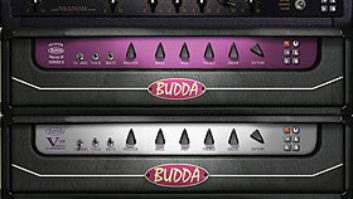Most folks who hear the name Demeter immediately think of the manufacturer’s well respected gates and mic preamps. Yet, for several people at last year’s AES show in L.A, one of the winners was Demeter’s new stereo spring reverb, the RV-1 Real Reverb. This limited-edition unit is a pure pleasure to work with and should find a place in any studio that needs a quiet analog reverb with personality.
Designed by James Demeter, the RV-1 is a 2-channel unit that takes up one rackspace and is 10 inches deep. The bulletproof chassis houses two Accutronix spring reverb tanks, each containing six springs. For added flexibility, channel 1’s reverb tank has a decay time of 1.5 seconds, while channel 2 decays in 3.5 seconds. The tanks are shielded to reduce noise, and each channel has its own dedicated connections.
The burnished-gold front panel of the RV-1 features the controls for each channel, ranged in identical pairs. Control knobs include input, mix and output, and two buttons flip the phase and engage a highpass/low-cut filter. Dividing the channel sections are two mode buttons that separately link the inputs and/or outputs or leave them in Stereo mode. Both channels have a red overload indicator next to the input knob.
There’s an emphasis on quality components and construction in the RV-1. The back panel I/O connectors are fully balanced XLR and ¼-inch TRS (Analog Devices 2142 and 2143 connectors). The unit also features an ±18V regulated power supply to optimize head-room and transit attack, and uses a custom-shielded, toroidal transformer to help lower noise. Connection is made via IEC cable, and you can select between 115V or 230V operation.
For this review, I compared the RV-1 to an Orban 111B, an AKG BX-20 and a spring reverb built into an old Electrocomp modular synth. The sound quality and imaging of the RV-1 unit blew away the Orban and equaled the dark character of both the AKG and Electrocomp. It never felt brittle or irritating—no tiny “springing” echo that would grate nerves. The sound had a clear vintage appeal with a modern studio feel.
Whether tracking or mixing, the RV-1 was a joy to work with. It provided a wonderful shimmer on acoustic and electric guitars, and gave my Minimoog depth and room to breathe. I found that gentle application of the RV-1 improved vocals I had tracked and stored to hard disk. I also recorded percussion through individual channels, occasionally tracking the “chirping” spring of the hi-hat to use later in a song. In general, the RV-1 added a wonderful, spacious quality to the finished stereo mixes I auditioned. While the difference in decay times between the channels was slightly noticeable on lighter instrumental passages, it never distracted me.
I primarily worked with the RV-1 in Stereo modes, but I also messed with the two Linked modes. These were fairly distinct in character. Linking the two inputs sums the input signals and sends the combination to both outputs, thus retaining some “stereo” flavor. Linking the outputs sums the output signals and yields a much more dramatic, tighter image. Reversing the phase of either channel while in this second output-combined setting brought subtle shifts to the tight image, creating a complex room-within-a-room feeling. I found this setting useful for emphasizing the center of the mix or even on stereo drum tracks. I also noticed a slight attenuation of highs when flipping the phase in both Linked and Stereo modes. One operational note: Reversing the phase while material plays will give an audible click. The highpass filter buttons, however, can be pushed in and out with no click.
A typical complaint with spring reverbs is that they’re noisy. The RV-1 is a surprisingly quiet unit. I didn’t find a need to gate the output, lift the ground of one channel or add a hum remover to the signal. Demeter cautions that strong EMF fields will introduce noise and advises that users can reduce EMF by linking the outputs and creating a hum-bucking configuration.
Given its versatility and features, the RV-1 is likely to be the best spring reverb you’ll find for your studio today. Not just for someone who has occasional fits of nostalgia, it’s suitable for serious applications and boasts a noise floor that’s competitive with many digital reverbs out there. At $699 list, the small initial run of 50 units should be snatched up fast by engineers who want a unique analog tool in their arsenal. Who knows how many more will be made? Grab one before they become a collector’s item.
Alex Artaud is a musician and engineer living in the Bay Area.



